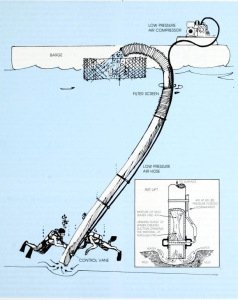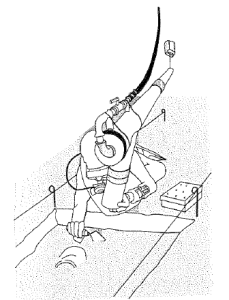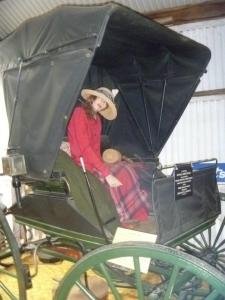posted by Marc Brown (Maritime student)
Excavation, it is one of the mainstays that we as archaeologists should have some grasp on. Without it we could only survey and on many occasions excavation is required to tell us more about the story of the site in question. But with excavation comes some major concerns that need to be addressed whether on a terrestrial site or an underwater site. Both require large amounts of planning and consideration before undertaking the destruction of a site, because that is exactly what excavation is — destruction. In order to excavate and find out more about that really interesting site, we must destroy it, and the only way to remember that valuable information, that is site context, is to conduct extensive planning, surveying and recording. Because once that first load of sand or dirt is removed, it cannot be put back how it was and that context is lost and this is why excavation, even though the public believes it to be all archaeology is, should only be considered as a last resort (Bowens 2008: 135). As with terrestrial archaeology, total excavation is rare and usually only samples or test pits are used to answer the questions we have for a site (Bowens 2008: 135).
Hand Fanning
There are three main ‘destructive’ methods which affect all archaeology: probing, sampling and excavation, but excavation is the one we will look at here. Hand fanning is the primary tool of any underwater archaeologists and it is also the cheapest and easiest way to remove small amounts of sediment. Hand fanning is a ‘gentle, rhythmic and circular movement of the hand over an object or feature to remove loose sand and silt without dislodging or damaging the item’ (Gould 2000: 61). Hand fanning is also useful when looking at larger scale excavations using an airlift or dredge, using the technique to move sediment to the mouth of the nozzle. These devices remove the sediment not only from the object, but also from the area (Gould 2000: 61-62). But remember the airlift or dredge nozzle is not supposed to be applied directly to the sediment but hovers just above it while the hand fanning moves the sediment into the tube.
Airlifts
An airlift is a device which uses a tube with air injected from a separate pipe at the bottom using an air compressor usually at the surface. This creates a suction effect as the air pushes its way back to the surface, taking any sediment with it. The problem with using an air compressor for the suction is that they usually need to be large and hence the boat they are on needs to be large enough to carry them (Bowens 2008: 144). The airlift should only ever be used to remove sediment, not things like weed accumulations (Bowens 2008: 145). Also, airlift efficiency increases with water depth (United States National Oceanic and Atmospheric Administration, Office of Undersea Research 1991: 9-38). The Airlift works best at depths greater than 5 metres and due to its buoyancy when filled with air must be anchored to the bottom somehow (Green 1990: 252-253).

Airlift operation diagram, from: United States National Oceanic and Atmospheric Administration, Office of Undersea Research 1991: 9-39
Water Dredge
A water dredge is an option instead of the airlift. They are similar except that a water dredge operates horizontally and uses water to create suction. These items are generally cheaper to run and are more effective in shallow water than an airlift (Bowens 2008: 145). It should be used in the same way as an airlift and again should not be used as a digging tool but should be fed sediment from the excavator. A problem with a water dredge is that it can damage the site and cause turbulence in the water from the discharge coming out at the other end. However, this can be combatted by lengthening the tube so that the discharge goes off site, but this can make the dredge hard to move (Bowens 2008: 146).

- Dredge operation, from: Bowens 2008: 146
Which is better?
So at this point you might be thinking ‘which is the better option for us budding underwater archaeologists?’ Well both have their advantages and disadvantages, airlifts are more efficient than a dredge but the dredge is cheaper to operate and works in shallow water. Therefore, we must consider what the conditions at the site are like as well as the funds available. If, for example, the excavation was taking place on a large scale site in deep water it would be easier to use an airlift, providing that the boat or ship is large enough to hold a large compressor. If it was a shallow water excavation with limited funds being conducted from a tinnie, then maybe consider a dredge. In the end it all comes down to funds and scale.
Limitations
Of course with any form of archaeological work, there are always limitations to be considered. With underwater archaeology the major limitation is placed squarely on the diver, how deep they can dive and for how long. Limited bottom times and the need for a decompression stop on deeper sites cause projects to run longer than if they were at a shallow depth. This is where only submersibles will give a long enough span of work to reduce the time required on site (Gould 2000: 62-63). Other limitations include, as mentioned before, the funding constraints. A large, high importance site will garner more funds meaning more time for excavation as well as better equipment whereas a backwater site of low importance may not have any equipment available beyond the boat and the hand, and this is why hand fanning is a vital tool because it does not require money to operate. Visibility is always a consideration underwater, if the site cannot be seen from up close there is little chance that photography and recording will be effective let alone accuracy when excavating.
In conclusion, it is always important to have a thorough plan when excavating in any context but sometimes even the best laid plans can go awry when working in an underwater environment because anything can happen to change the plans such as bad weather or poor visibility. This is when a secondary plan is vital. So, the moral of the story is plan, plan, plan, and then when you think you have a thorough plan, plan some more.
References:
Bowens, A (ed.) 2008 Underwater Archaeology: The NAS Guide to Principles and Practice. 2nd Edition. Wiley-Blackwell, London
Gould, R. 2000 Archaeology and the Social History of Ships. Cambridge University Press, England
Green, J. 1990 Maritime Archaeology: A Technical Handbook. Academic Press, London
United States National Oceanic and Atmospheric Administration, Office of Undersea Research 1991 NOAA Diving Manual: Diving for Science and Technology, Section 9



